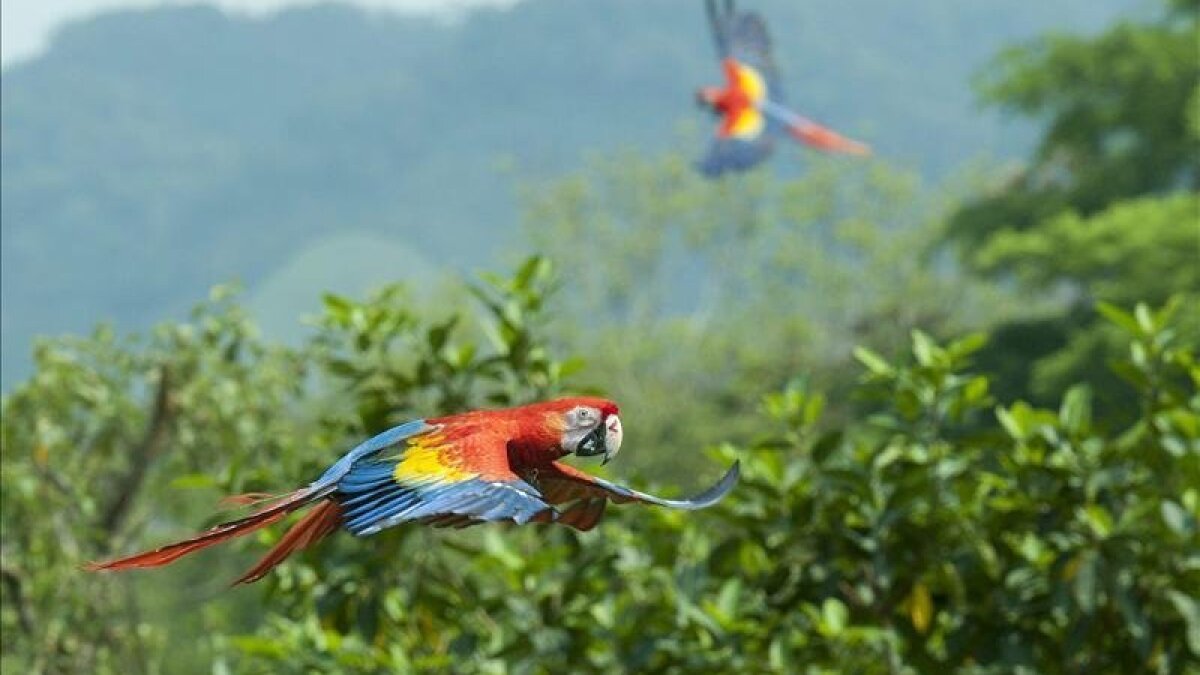An initiative of Xcaret Park and Aluxes Ecoparque reintroduce this colorful bird to its habitat.
The scarlet macaws saw their population decimated in the Mexican territory, so the conservation of these and their reinsertion in the Mexican jungles has been taken with special care.

On May 28, 2022, 16 scarlet macaws (Ara macao cyanoptera) were transferred to “Aluxes Ecoparque”, a non-profit Civil Association based in Palenque, Chiapas. These specimens will be placed in a temporary shelter for their gradual adaptation and familiarization with their new home. The next step in the coming months will be to release them into their natural habitat, in nearby forests in the Palenque area.

This exercise has been the result of a macaw reproduction program, the project began in 1993 in Xcaret Park ; continued in 2012 with reintroduction actions, and to date a total of 197 specimens have been successfully released in the “Nanciyaga Ecological Reserve” and other sites in the forest regions of the state of Veracruz; additional to these are 120 (considering the latter 16) in Aluxes Ecoparque. That is, a total of 317 macaws, with a calculated survival rate of 77%. In the 90s there were only 240 macaws in the wild in Mexico and they were very likely going to disappear
Reintegration into natural habitats is a complex process for animals that have spent time in captivity, in addition to the risks they face in wild spaces that compromise their survival, however, the result continues to be positive for the Xcaret Park initiative.
“When we started our reintroduction program in the 1990s, there were only 240 macaws in the wild in Mexico and they were very likely going to disappear. Thanks to this initiative, which has been made possible thanks to the Corporate Conservation Department led by Rodolfo Raigoza, we have doubled the wild population of macaws in two reserve areas, such as Chiapas and Veracruz, where it should be noted that they were already extinct due to more than 70 years. Today we are proud to see reflected in hundreds of lives, the more than 30 years of research and work to conserve this beautiful species”, explained Iliana Rodríguez, Corporate Director of Sustainability and Institutional Relations of Grupo Xcaret. Chiapas and Veracruz, macaws were already extinct 70 years ago

For the reintroduction of birds, Xcaret Park implements actions from 6 fundamental axes:
- Analysis of sites for reintroduction. Viable sites for reintroduction are monitored and the characteristics of said area are analyzed, such as: type of species that live in the ecosystem, possible predators, availability of food and water. This allows them to assess that the reintroduction site will be suitable for the species.
- Analysis of genetic variability. It has collaborated with various institutions such as the UNAM Institute of Biology to carry out genetic mapping and detect whether the specimens transferred from Xcaret Park are viable for reintroduction into Mexican jungles.
- Behavior analysis and adaptability. For a specimen to survive in the wild, it must be raised by its parents or under human care, in a non-invasive way, to ensure that these specimens will be able to develop natural behaviors of their species and, above all, survive without human help.
- Health status analysis. Parque Xcaret has a preventive medicine program that guarantees the health of the specimens, through medical check-ups, internal and external deworming, weight and height checks, and evaluation of the general state of nutrition. Constantly reviewing their health status ensures that the specimens have the necessary conditions to survive. Prior to the transfer of specimens, an exhaustive medical examination is carried out.
- Transfer to reintroduction sites. Once these specimens are suitable for reintroduction, they are transferred to the site and after several months of adaptation, they are incorporated into their habitat in the wild.
- Monitoring. A fundamental part of this project requires monitoring the location and flight of the specimens in order to indirectly evaluate their health status and, in turn, identify if new pairs have been formed and detect births in the wild.



